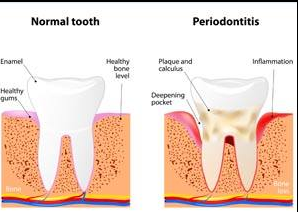Gum Disease and Gingivitis

Gum Disease and Gingivitis What is Gum Disease? Periodontal disease is also known as Gum Disease and is defined as: Peri- meaning around - dontal meaning tooth Disease is any damage or injury that impairs an organism's function What Causes Gum Disease and Gingivitis? The tissues and supporting bone around a tooth may be attacked by specific bacteria , this can cause the teeth t o become loose and cause tooth loss, t he bacteria cause a gum infection. The specific bacteria that cause Gum Disease, Gingivitis, and Periodontal Disease are Anaerobic bacteria. This means that they can only survive in an environment without oxygen . 3. How to Prevent This is why flossing and brushing your teeth daily is important, so you can remove the debris, disrupt the biofilm forming, and allow oxygen to reach the pockets between your gums and teeth. 3. Warning Signs of Gum Disease Gums that bleed when you brush your teeth Red, swollen and tending gum